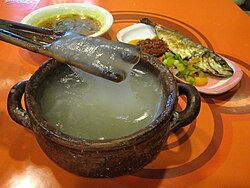This article needs additional citations for verification. (August 2012) |
 Papeda served with yellow soup and grilled mackerel called tongkol | |
| Alternative names | Popeda, Pepeda, Bubur Sagu, Nangu, Kapurung, Sinonggi |
|---|---|
| Course | Main course, staple food |
| Place of origin | Indonesia |
| Region or state | Sulawesi, Maluku and coastal Papua |
| Serving temperature | Hot or room temperature |
| Main ingredients | Sago |
Papeda, or bubur sagu, is a type of congee made from sago starch. It is a staple food of the people indigenous to Eastern Indonesia, namely parts of Sulawesi,[1] the Maluku Islands and coastal Papua.[2] It is also widespread in Papua New Guinea and serves as the counterpart to central and western Indonesian cuisines that favour rice as their staple food.[3]
The starch is acquired by felling the trunk of a sago palm tree, cutting it in half, and scraping the soft inner parts of the trunk, the pith, producing a crude sago pith flour. This flour is then mixed with water and squeezed to leach the starch from the flour. The still-moist sago starch is usually stored in a container made of sago palm leaflets, called tumang, in which it will keep for several months before spontaneous fermentation will turn it too acidic and unsuitable for making papeda. Depending on the variety and the growing conditions, it may take a sago tree five to over ten years to accumulate enough starch in its trunk to make the effort of extracting it worthwhile.[4]
Papeda is made by cooking sago starch with water and stirring until it coagulates and becomes more translucent. It has a glue-like consistency and texture.[2] Sayur bunga pepaya (papaya flower bud vegetables) and tumis kangkung (stir-fried water spinach) are often served as side-dish vegetables to accompany papeda.[3]
- ^ Cite error: The named reference
Kirana 2020was invoked but never defined (see the help page). - ^ a b "Papeda, Maluku: Bubur 'Lem' Segar Bergizi". Femina (in Indonesian). Retrieved 9 March 2015.
- ^ a b Agung BS (10 December 2013). "Papeda, Makanan Sehat Khas Papua". Tribun News (in Indonesian). Retrieved 9 March 2015.
- ^ Schuiling, D.L. (2009) Growth and development of true sago palm (Metroxylon sagu Rottbøll) with special reference to accumulation of starch in the trunk: a study on morphology, genetic variation and ecophysiology, and their implications for cultivation. (PhD thesis Wageningen University).